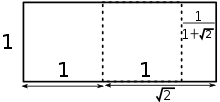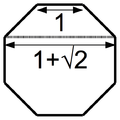Silver ratio
In mathematics, two quantities are in the silver ratio (or silver mean)[1][2] if the ratio of the sum of the smaller and twice the larger of those quantities, to the larger quantity, is the same as the ratio of the larger one to the smaller one (see below). This defines the silver ratio as an irrational mathematical constant, whose value of one plus the square root of 2 is approximately 2.4142135623. Its name is an allusion to the golden ratio; analogously to the way the golden ratio is the limiting ratio of consecutive Fibonacci numbers, the silver ratio is the limiting ratio of consecutive Pell numbers. The silver ratio is denoted by δS.

| Binary | 10.01101010000010011110… |
| Decimal | 2.4142135623730950488… |
| Hexadecimal | 2.6A09E667F3BCC908B2F… |
| Continued fraction | |
| Algebraic form | 1 + √2 |

Mathematicians have studied the silver ratio since the time of the Greeks (although perhaps without giving a special name until recently) because of its connections to the square root of 2, its convergents, square triangular numbers, Pell numbers, octagons and the like.
The relation described above can be expressed algebraically:
or equivalently,
The silver ratio can also be defined by the simple continued fraction [2; 2, 2, 2, ...]:
The convergents of this continued fraction (2/1, 5/2, 12/5, 29/12, 70/29, ...) are ratios of consecutive Pell numbers. These fractions provide accurate rational approximations of the silver ratio, analogous to the approximation of the golden ratio by ratios of consecutive Fibonacci numbers.
The silver rectangle is connected to the regular octagon. If a regular octagon is partitioned into two isosceles trapezoids and a rectangle, then the rectangle is a silver rectangle with an aspect ratio of 1:δS, and the 4 sides of the trapezoids are in a ratio of 1:1:1:δS. If the edge length of a regular octagon is t, then the span of the octagon (the distance between opposite sides) is δSt, and the area of the octagon is 2δSt2.[3]
Calculation
For comparison, two quantities a, b with a > b > 0 are said to be in the golden ratio φ if,
However, they are in the silver ratio δS if,
Equivalently,
Therefore,
Multiplying by δS and rearranging gives
Using the quadratic formula, two solutions can be obtained. Because δS is the ratio of positive quantities, it is necessarily positive, so,
Properties


Number-theoretic properties
The silver ratio is a Pisot–Vijayaraghavan number (PV number), as its conjugate 1 − √2 = −1/δS ≈ −0.41 has absolute value less than 1. In fact it is the second smallest quadratic PV number after the golden ratio. This means the distance from δ n
S to the nearest integer is 1/δ n
S ≈ 0.41n. Thus, the sequence of fractional parts of δ n
S, n = 1, 2, 3, ... (taken as elements of the torus) converges. In particular, this sequence is not equidistributed mod 1.
Powers
The lower powers of the silver ratio are
The powers continue in the pattern
where
For example, using this property:
Using K0 = 1 and K1 = 2 as initial conditions, a Binet-like formula results from solving the recurrence relation
which becomes
Trigonometric properties
The silver ratio is intimately connected to trigonometric ratios for π/8 = 22.5°.
So the area of a regular octagon with side length a is given by
Paper sizes and silver rectangles

A rectangle whose aspect ratio is the silver ratio (1:√2, approximately 1:1.4142135 decimal) is sometimes called a silver rectangle by analogy with golden rectangles. The paper sizes under ISO 216 are such rectangles. The 1:√2 rectangles (rectangles with the shape of ISO 216 paper) have the property that by cutting the rectangle in half across its long side produces two smaller rectangles of the same aspect ratio.
Removing a largest possible square from such a rectangle leaves a rectangle with proportions 1 : (√2 − 1) which is the same as (1 + √2) : 1, the silver ratio. Removing a largest square from the resulting rectangle leaves one again with aspect ratio 1:√2.[4] Removing the largest possible square from either kind of silver rectangle yields a silver rectangle of the other kind, and then repeating the process once more gives a rectangle of the original shape but smaller by a linear factor of 1 + √2.[3]
See also
References
- Vera W. de Spinadel (1999). The Family of Metallic Means, Vismath 1(3) from Mathematical Institute of Serbian Academy of Sciences and Arts.
- de Spinadel, Vera W. (1998). Williams, Kim (ed.). "The Metallic Means and Design". Nexus II: Architecture and Mathematics. Fucecchio (Florence): Edizioni dell'Erba: 141–157.
- Kapusta, Janos (2004), "The square, the circle, and the golden proportion: a new class of geometrical constructions" (PDF), Forma, 19: 293–313.
- Lister, David. "The A4 rectangle". The Lister List. England: British Origami Society. Retrieved 2009-05-06.
Further reading
- Buitrago, Antonia Redondo (2008). "Polygons, Diagonals, and the Bronze Mean", Nexus Network Journal 9,2: Architecture and Mathematics, p.321-2. Springer Science & Business Media. ISBN 9783764386993.
External links
- Weisstein, Eric W. "Silver Ratio". MathWorld.
- "An Introduction to Continued Fractions: The Silver Means", Fibonacci Numbers and the Golden Section.
- "Silver rectangle and its sequence" at Tartapelago by Giorgio Pietrocola

